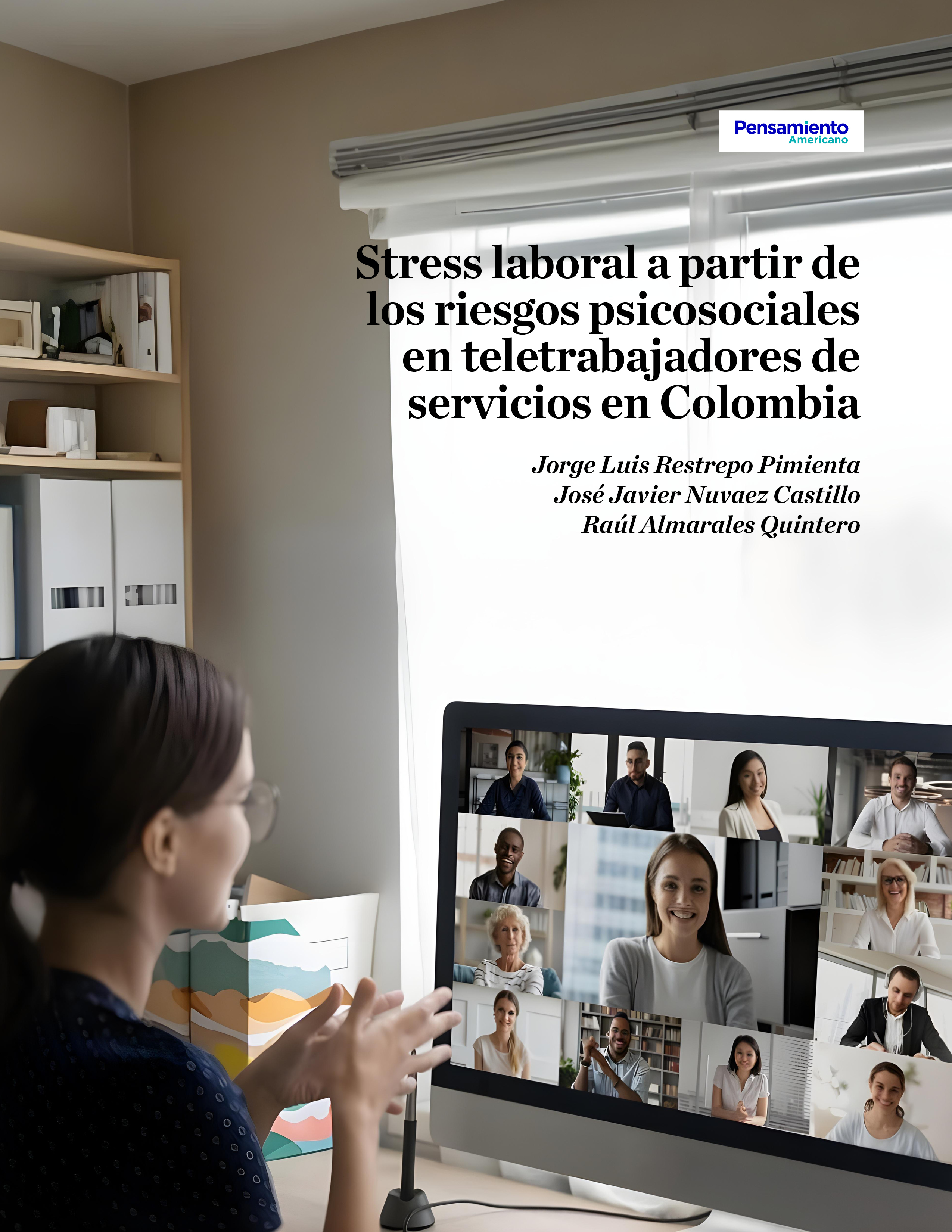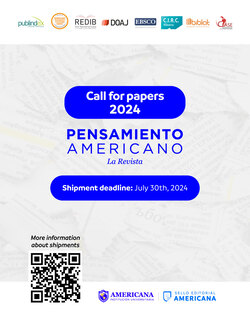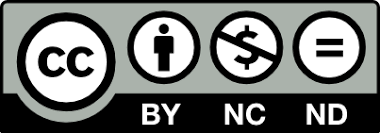Occupational stress based on psychosocial risks in teleworkers in Colombia.
DOI:
https://doi.org/10.21803/penamer.18.37.892Keywords:
Occupational well-being, Workplace stress, Psychosocial risks, Occupational health and safety, TeleworkingAbstract
Introduction: This research identifies work-related stress associated with psychosocial risks among teleworkers in the service sector in Colombia, who are exposed to physical and mental disorders that significantly impact their family and social environments.
In response, companies are seeking strategies to mitigate these effects. Objective: To analyze work-related stress based on psychosocial risks in teleworkers in Colombia. Methodology: A qualitative study was conducted using a hermeneutic documentary
approach. The research employed techniques such as observation, document analysis, and literature review, supported by instruments including bibliographic cards, summaries, concept maps, synoptic charts, and essays, following a rigorous logical-methodological structure. Results: Teleworking operates within a highly competitive environment that demands constant productivity. The pressure exerted by employers increases the level of demands placed on workers, contributing to the emergence of work-related
stress and adversely affecting their physical and mental health. Conclusions: Work-related stress is a recognized occupational disease that significantly affects teleworkers. Therefore, it is essential to implement preventive occupational health and safety programs
to avoid the chronicity of associated disorders and to promote the comprehensive well-being of workers.
Downloads
References
Cano Vindel, Antonio, presidente de la SEAS Sociedad Española para el Estudio de la Ansiedad y el Estrés, (2019), consecuencias del estrés laboral [Consultado el 16/05/2019 a las 10:07 a.m.] disponible en https://webs.ucm.es/info/seas/estres_lab/consecue.htm
Ferro, M., Gutiérrez, C., & López, J. C. (2018). Intervención en los factores de riesgo psicosociales intralaborales, que generan niveles altos de estrés laboral, en los trabajadores de una institución educativa de básica y media vocacional, de la ciudad de Bogotá D.C. [Corporación Universitaria Minuto https://repository.uniminuto.edu/bitstream/10656/8201/1/PROYECTO Dios]. DE INVESTIGACIÓN INTERVENCIÓN EN LOS FACTORES DE RIESGO PSICOSOCIALES INTRALABORALES %283%29.pdf Foguet-Boreu, Q., &
Foguet-Boreu, Q., & Ayerbe García-Morzon, L. (2021). Estrés psicosocial, hipertensión arterial y riesgo cardiovascular. Hipertensión y Riesgo Vascular, 38(2), 83–90
Ganster, D. C., & Rosen, C. C. (2013). Work Stress and Employee Health: A Multidisciplinary Review. Journal of Management, 39(5), 1085–1122.
Glazer, S., & Liu, C. (2017). Work, Stress, Coping, and Stress Management. Oxford Research Encyclopedia of Psychology, 30, 1–19. https://doi.org/10.1093/ACREFORE/9780190236557.013.30.
González Ramírez, M. T., & Landero Hernández, R. (2006). Síntomas psicosomáticos y teoría transaccional del estrés. Ansiedad y Estrés, 12(1), 45–61.
Gutiérrez, A., & Viloria-Doria, J. C. (2014). Riesgos Psicosociales y Estrés en el ambiente laboral. Salud Uninorte. Barranquilla, 30(1), v–vi. http://apps.who.int/iris/bitstre.
Hammer, L. B., Truxillo, D. M., Bodner, T., Rineer, J., Pytlovany, A. C., & Richman, A. (2015). Effects of a Workplace Intervention Targeting Psychosocial Risk Factors on Safety and Health Outcomes. BioMed Research International, 2015, 836967. https://doi.org/10.1155/2015/836967.
Hernández, R., Fuente, M. J., & Martínez, C. (2020). La influencia del estrés laboral en el desempeño de los trabajadores en la empresa LGM Gestión Empresarial S.A.S [Corporación Universitaria Iberoamericana]. https://repositorio.ibero.edu.co/.
Ivancevich John M, (2004), Administración de recursos humanos, México. Mcgraw-hill /.
Maddux, R. E., Daukantaité, D., & Tellhed, U. (2017). The effects of yoga on stress and psychological health among employees: an 8- and 16-week intervention study. 31(2), 121134.
Mejía, C. R., Chacon, J. I., Enamorado, O. M., Garnica, L. R., Chacón, S. A., & García, Y. A. (2019). Factores asociados al estrés laboral en trabajadores de seis países de Latinoamérica. Rev. Asoc. Esp. Espec. Med. Trab, 28(3), 204–211. http://scielo.isciii.es/pdf/medtra/v28n3/1132-6255-medtra-28-03-204.pdf.
Ministerio de Trabajo. (2013). Informe Ejecutivo de la Segunda Encuesta Nacional de Condiciones de Seguridad y Salud en el Trabajo en el Sistema General de Riesgos Laborales de Colombia de Riesgos (Segunda). Ministerio de trabajo. http://www.fasecolda.com/files/1614/4969/7446/Ministerio_del_Trabajo._2013._II_Encuesta_Nacional_de_Condiciones_de_Seguridad_y_Salud_en_el_Trabajo_en_el_Sistema _General_de_Riesgos_Laborales.pdf.
Mora, A., Niño Castillo, B., Mendoza Valencia, C. P., & Moreno, S. A. N. (2018). Propuesta de intervención para riesgo psicosocial y estrés laboral encontrados en el diagnóstico 2017 en una empresa del sector farmacéutico. Corporación Universitaria Minuto de Dios.
Moreno Daza, J., Cárdenas Quijano, C., Cárdenas Beltrán, J. M., Nieto Aldana, J. C., Lopera Sánchez, J. J., Moreno Daza, J., Cárdenas Quijano, C., Cárdenas Beltrán, J. M., (2021). Impacto del entrenamiento en resiliencia y manejo del estrés: estudio de caso en la Policía Nacional de Colombia. Revista Logos Ciencia & Tecnología, 13(1), 96–115.
Moreno Jiménez, B. (2011). Factores y riesgos laborales psicosociales: conceptualización, historia y cambios actuales. Medicina y Seguridad Del Trabajo, 57(1), 4–19.
Nieto Aldana, J. C., & Lopera Sánchez, J. J. (2021). Impacto del entrenamiento en resiliencia y manejo del estrés: estudio de caso en la Policía Nacional de Colombia. Revista Logos Ciencia & Tecnología, 13(1), 96–115.
Niks, I., Jonge, J. De, Gevers, J., & Houtman, I. (2018). Work Stress Interventions in Hospital Care: Effectiveness of the DISCovery Method. International Journal of Environmental Research and Public Health 2018, Vol. 15, Page 332, 15(2), 332. https://doi.org/10.3390/IJERPH15020332.
Ríos, E., & Alférez, M. A. (2020). Estrategias de afrontamiento frente al estrés relacionado con el trabajo en casa, en mujeres adultas cabeza de hogar de Villavicencio. Universidad Cooperativa de Colombia.

Downloads
Published
Issue
Section
License
Copyright (c) 2025 Pensamiento Americano

This work is licensed under a Creative Commons Attribution-NonCommercial-NoDerivatives 4.0 International License.
The author or authors of an article accepted for publication in the Journal Pensamiento Americano will transfer all of the patrimonial rights to the American University Corporation free of charge, within which are included: the right to edit, publish, reproduce and distribute both print media as digital, in addition to include in article in international indexes and / or databases, likewise, the Editorial Seal is authorized to use the images, tables and / or any graphic material presented in the article for the design of covers or posters from the same magazine. By assuming the patrimonial rights of the article, it may not be partially or totally reproduced in any printed or digital media without its express permission.
AUTHORITY ASPECTS
For the Pensamiento Americano Journal, all the authors of an article have made substantial contributions to the research and the manuscript, and they share the responsibility when the article presents errors, fraud in some way or violations of copyright.
After submitting an article, the journal does not accept the addition, deletion or change in the order of the authors, in addition we reserve the right to release the article when it has been submitted to the journal and under no circumstances will American Thought accept the article. withdrawal of an article during any phase of the editorial process





